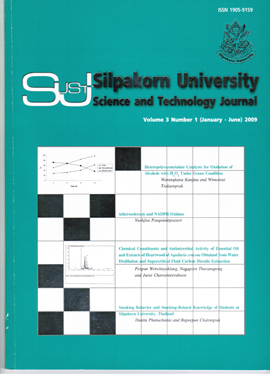Atherosclerosis and NADPH Oxidase
Main Article Content
Abstract
Vascular diseases including coronary artery disease, cerebrovascular and peripheral vascular diseasesare the largest cause of mortality and morbidity. Reactive oxygen species (ROS), especially superoxide (O2•-)have been implicated in the pathogenesis of virtually every stage of vascular lesion formation in atherosclerosis.Atherosclerosis is a disease affecting arterial blood vessels. It is a chronic inflammatory response in thewalls ofarteries, in large part to the deposition of lipoproteins (plasma proteins that carry cholesterol and triglycerides).Oxidation of low density lipoprotein (LDL) was injurious to arterywall cells and suggested that LDL oxidationmight be important in atherogenesis. Among the potential sources of ROS, the NADPH oxidases appear to beespecially important for redox signalling and indeed possess several biochemical properties thatmake themwellsuited for involvement in signal transduction. The NADPH oxidase systemplays a key role in generating ROS,including O2•- and hydrogen peroxide (H2O2) in phagocytic cells, fibroblasts, vascular smoothmuscle cells, andendothelial cells. The NADPHoxidase systemis regulated systemically in veins and arteries, which strengthensthe importance of the molecular regulation of the enzyme in cardiovascular disease (CVD), especiallyatherosclerosis.
Downloads
Article Details
References
Cathcart, M. K. (2004). Regulation of superoxide anion production by NADPH oxidase in monocytes/macrophages contributions to atherosclerosis. Arteriosclerosis, Thrombosis, and Vascular Biology, 24: 23-28.
Channon, K. M. and Guzik, T. J. (2002). Mechanisms of superoxide production in human blood vessels: relationship to endothelial dysfunction, clinical and genetic risk factors. Journal of Physiology and Pharmacology, 53(4): 515-524.
Dusting, G. J, Selemidis, S., and Jiang, F. (2005). Mechanism for suppressing NADPH oxidase in the vascular wall. Mem Inst Oswaldo Cruz, Rio de Janeiro 100 (Suppl. 1): 97-103.
Dworakowski, R., Anilkumar, N., Zhang, M., and Shah, A. M. (2006). Redox signalling involving NADPH oxidase-derived reactive oxygen species. Biochemical Society Transactions, 34: 960-964.
Fortuño, A., José, G. S., Moreno, M. U., Diez, J., and Zalba, G. (2005). Oxidative stress and vascular remodelling. Experimental Physiology, 90: 457-462. https://www.britannica.com/eb/article-9010075/atherosclerosis accessed on July 5, 2007.
Kalayoglu, M. V., Hoerneman, B., Verda, L. D., Morrison, S. G., Morrison, R. P., and Byrne, G. I. (1999). Cellular oxidation of low-density lipoprotein by Chlamydia pneumoniae. The Journal of Infectious Diseases, 180: 780-790.
Li, J.-M. and Shah, A. M. (2003). ROS generation by nonphagocytic NADPH oxidase: Potential relevance in diabetes nephropathy. Journal of the American Society of Nephrology, 14: S221-S226.
Libby, P. (2002). Inflammation in atherosclerosis.Nature, 420: 868-874.
Loomis, E. D., Sullivan, J. C., Osmond, D. A., Pollock, D. M., and Pollock, J. S. (2005). Endothelin mediated superoxide production and vasoconstriction through activation of NADPH oxidase and uncoupled nitric-oxide synthase in the rat aorta. The Journal of Pharmacology and Experimental Therapeutics, 315(3): 1058-1064.
Micié, D. D. (2006). Insulin resistance and atherosclerosis. Jugoslov Med Biochem, 25(4): 343-348.
Navab, M., Ananthramaiah, G. M., Reddy, S. T., Lenten, B. J. V., Ansell, B. J., Fonarow, G. C., Vahabzadeh, K., Hama, S., Hough, G., Kamranpour, N., Berliner, J. A., Lusis, A. J., and Fogelman, A. M. (2004). The oxidation hypothesis of atherogenesis: The role of oxidized phospholipids and HDL. Journal of Lipid Research, 45: 993-1007.
Park, J. Y., Ferrell, R. E., Park, J. J., Hagberg, J. M., Phares, D. A., Jones, J. M., and Brown, M. D. (2005). NADPH oxidase p22phox gene variants are associated with systemic oxidative stress biomarker responses to exercise training. Journal of Applied Physiology, 99: 1905-1911.
Ray, R. and Shah, A. M. (2005) NADPH oxidase and endothelial cell function. Clinical Science, 109: 217-226.
Ross, R. (1988). The Pathogenesis of Atherosclerosis. Heart Disease (Braunwald, E, ed),pp. 1135-1152. W.B. Saunders company, Philadelphia.
Schnackenberg, C. G. (2002). Physiological and pathophysiological roles of oxygen radicals in the renal microvasculature. The American Journal of Physiology-Regulatory, Integrative and Comparative Physiology, 282: R335-R342.
Siow, Y. L., Au-Yeung, K. K. W., Woo, C. W. H., and Karmin, O. (2006). Homocysteine stimulates phosphorylation of NADPH oxidase p47phox and p67phox subunits in monocytes via protein kinase Cβ activation. Biochemical Journal, 398: 73-82.
Steinberg, D. (2009). The LDL modification hypothesis of atherogenesis: an update. Journal of Lipid Research: 1-25.
Xia, L., Wang, H., Goldberg, H. J., Munk, S., Fantus, I. G., and Whiteside, C. I. (2006). Mesangial cell NADPH oxidase upregulation in high glucose is protein kinase C dependent and required for collagen IV expression. American Journal of Physiology-Renal Physiology, 290: F345-F356.

